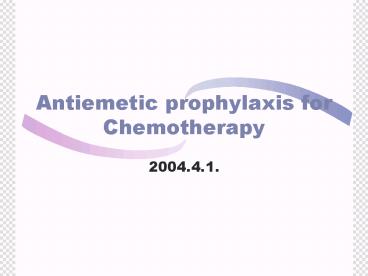Antiemetic prophylaxis for Chemotherapy - PowerPoint PPT Presentation
1 / 23
Title:
Antiemetic prophylaxis for Chemotherapy
Description:
dopamine receptor antagonist (benzamide, metoclopramide), butyrophenones ... Emetic Afferent signal: 1) CTZ (chemoreceptor trigger zone) : area postrema ... – PowerPoint PPT presentation
Number of Views:345
Avg rating:3.0/5.0
Title: Antiemetic prophylaxis for Chemotherapy
1
Antiemetic prophylaxis for Chemotherapy
- 2004.4.1.
2
Progress in Antiemetics
- 1960-1980s
- dopamine receptor antagonist (benzamide,
metoclopramide), butyrophenones (haloperidol,
droperidol), corticosteroid - 1990s serotonin receptor antagonist
- 1999 ASCO guideline
- 2000-2004 substance P, NK-1 receptor antagonist
3
- Neurophysiology of Emesis
- 1999 ASCO guidelines Recommendations for the use
of antiemetics - Problems poor compliance with guideline and
delayed emesis - A New Agent NK-1 receptor antagonist
4
- Neurophysiology of Emesis
- 1999 ASCO guidelines Recommendations for the use
of antiemetics - Problems poor compliance with guideline and
delayed emesis - A New Agent NK-1 receptor antagonist
5
Neurophysiology of Emesis
- Neurotransmitter
- dopamine, acetylcholine, histamine,
serotonin, opiates and substance P - Emetic Afferent signal
- 1) CTZ (chemoreceptor trigger zone) area
postrema - 2) Enterochromaffin cell
- 3) Limbic system
- 4) labyrinth
6
Emetic Signal Neurotransmitter
- Area Postrema highly vascularized with
fenestrated vessels, which lack tight junctions
between capillary endothelial cells, so
anatomically specialized to readily sample
elements present in the circulating blood and
cerebrospinal fluid - Enterochromaffin Cell release 5-HT(serotonin)
and activate 5-HT receptors on vagal nerve
7
5-hydroxytryptamine(5-HT)
- Cisplatin generate free radical and cause
calcium-dependent exocytic release of serotonin
from enterochromaffin cells in GI tract - Increase in urinary output of 5-HIAA (metabolite
of 5-HT) within 24hrs after cisplatin
administration - 5-HIAA response profile correlated with time
course of clinical efficacy of profile of 5-HT3
RA - 5-HT3 RA respond poorly since 24hrs after
chemotherapy, so 5-HT is NOT believed to be a
significant mediator of delayed emesis.
8
Substance P
- High level in area postrema of dogs(Amin, 1954)
- Co-localized with serotonin in enterochromaffin
cells - Elevation of substance P level in peripheral
circulation since 24hrs after cisplatin
administration (Matsumoto, 1999) - May have major role in delayed emesis!
9
Serotonin vs substance P
- Ondansetron
- antagonist 5-HT Rc
- acts mainly acute phase of vomiting
- L-758298
- antagonist of substance P
- acts mainly delayed phase of vomiting
- (Hesketh, 2003)
10
- Neurophysiology of Emesis
- 1999 ASCO guidelines Recommendations for the use
of antiemetics - Problems poor compliance with guideline and
delayed emesis - A New Agent NK-1 receptor antagonist
11
1999 ASCO Guidelines for Antiemetics Acute
Emesis
Antiemetics prescription according to the emetic
risk of patient characterstics and
chemotherapeutic agents!
high risk prior chemotherapy, female sex, a low
chronic alcohol intake or history, and younger age
High Risk(gt30) cisplatin, carboplatin,
cytoxan... Intermediate Risk(10-30) irinotecan,
taxol,docetaxel Low risk(lt10) vinorelbine,
fluorouracil, tamoxifen
12
5-HT RA Corticosteroid
- Complete control rate of acute emesis
75(58-96) - 5-HT RA corticosteroid combination yield
greater antiemetic protection than single 5-HT RA
- Better emetic control than metoclopramidecorticos
teroid - Regimens of choice for patients receiving
cisplatin or noncisplatin chemotherapy of high
emetic risk
(The Italian Group for Antiemetic Research,
1995)
13
5-HT RA All Equivalent Efficacy
- granisetron, dolasetron, ramosetron pure 5-HT3
antagonist - Ondansetron, tropisetron weak antagonists at the
5-HT4 receptor - All 5-HT RA have equivalent safety and efficacy
- Single dose before chemotherapy, with oral form
14
1999 ASCO Guidelines for Antiemetics Delayed
Emesis
The Most Important patient characteristics
predicting for greater risk for delayed
emesis Poor control of acute emesis
- 5-HT RA corticosteroid vs Metoclopramide
corticosteroid - Equivalent for delayed emesis
- Favor metoclopramide d/t cost
15
Problems Poor Compliance with Guideline
- Adherence to Acute emesis prophylaxis guideline
more than 90 - But for delayed emesis, prescription of
corticosteroid is too often omitted - Mertens et al(2003) postchemotherapy DN
prophylaxis - steroid25
- 5-HT RA 52
- metoclopramide50
- 5-HT RA with steroid after cisplatin none
16
- Neurophysiology of Emesis
- 1999 ASCO guidelines Recommendations for the use
of antiemetics - Problems poor compliance with guideline and
delayed emesis - A New Agent NK-1 receptor antagonist
17
Problems Delayed Emesis
- Without acute emesis, delayed emsis can be
protected with dexa 5HT RA more effectively
than dexamethasone alone - Once acute emesis occurs, delayed emesis cannot
be protected effectively with any regimen
The Italian Group for Antiemetic Research, 2000
18
- Neurophysiology of Emesis
- 1999 ASCO guidelines Recommendations for the use
of antiemetics - Problems poor compliance with guideline and
delayed emesis - A New Agent NK-1 receptor antagonist
19
Neurokinin-1 receptor antagonist
Standard Regimen Granisetron Dexamethasone
- Neurokinin-1 receptor antagonist antagonism of
substance P - L-754,030 significant reduction of acute and
delayed emesis (Navari,
1999)
L754,030 only before chemotherapy
L754,030 before and after chemotherapy
20
Aprepitant (EMEND)
- Selective NK-1 receptor antagonist
- Dose 120mg before chemotherapy, 80mg D2-3 or
D2-5 - Approved by FDA on Mar 2003
- Interaction with corticosteroid increase serum
concentration of corticosteroid because
aprepitant is a inhibitor of cytochrome P 450 3A4
21
Aprepitant on phase III trial
- Add aprepitant to standard 5-HT RA
corticosteroid sinificant reduction of acute and
delayed emesis
22
Aprepitant on phase III trial
- With aprepitant, consistently better antiemetic
protection can be maintained over multiple cycle
compared with standard regimen
23
Epilogue
- Antiemetics allows to be treated comfortably on
an outpatient basis and eliminates nutritional
problem - Newer Agent NK-1 Receptor Antagonist
- Review of current antiemetic regimen risk
stratification, dose, schedule..































